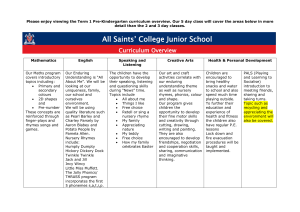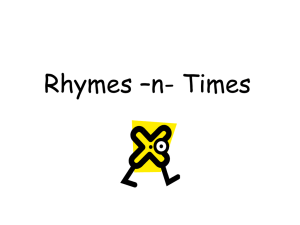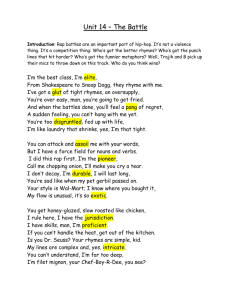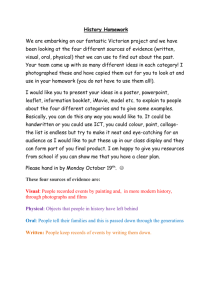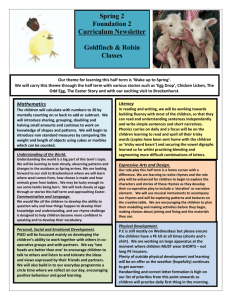An Examination of Mother Goose:
advertisement
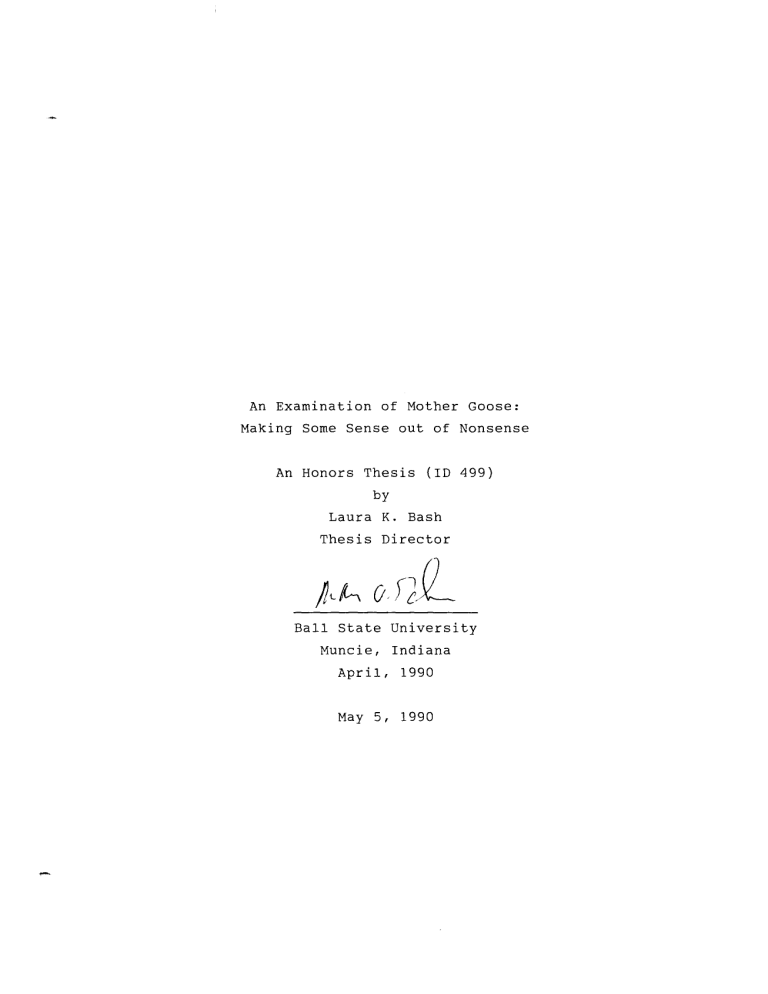
An Examination of Mother Goose:
Making Some Sense out of Nonsense
An Honors Thesis (ID 499)
by
Laura K. Bash
Thesis Director
Ball State University
Muncie, Indiana
April, 1990
May 5, 1990
.-
1'190
,03'1'4
Funny isn't
it, how
last week, but you're
memories that
you can't remember what you did
able
to
remain vivid
recall
despite the
clearest and fondest memories from my
was six years old.
to
start
food, or
eating
was like
food.
to get
engaging in
everything, but what finally
about a
One of my
childhood is
I should
baby
cooperative child, and trying
not spit,
years.
when I
At that time my younger sister was just
beginning to eat baby
enough
numerous childhood
small boy
say she
She
was
her to
combat.
worked was
was old
not
a
swallow, but
My mother tried
the famous jingle
who terrorizes girls on the playground.
This boy was Mother Goose's own
Georgie Porgie.
We tried
many other distracters after this, but my sister refused to
eat unless Georgie
was
sung
continuously--it
exhausting for those singing, but she loved it.
got
to be
It was her
first experience with nursery rhymes, and it was a smashing
success.
The episode
rhymes;
tongue.
I
was
I
had
was hardly
already
a
expertly
record
rhymes, and I listened to
verbatim.
Seventeen
my first
which
introduction to the
tripping
them
off the
told stories about the
it
until
I
could
recite them
years
later
I am as captivated by
these compact masterpieces as that five year old girl.
more
I
learned
controversy they
about
The
the rhymes, their history, and the
sometimes
spark,
the
more
intrigued I
2
-
became to
study them further.
although I believe I
discovered
have only
fascinating
"Mother Goose"
have been.
controversy as
scratched the
theories
actually was,
players might
suitable for
And so I have learned more,
as
to
as well
surface.
I
who
the revered
as who
some of her
Most amazingly, I found a heated
to whether
the Lady's
rhymes are actually
young children, or whether they model deviant
behavior and encourage violence.
So just
abound, my
who
was
Mother
personal feeling
of both her charm
Although theories
Goose?
is that her anonymity is part
and success.
As
varied as
her rhymes
however, are the explanations as to her identity.
well-known theories are
often
more
sound
as
intense
fanciful
research,
although lacking
logical
easy
to
discover,
theories
can
be
One
of
two famous
the
of Charlemagne
two
French folklore
as sitting
and, so the story
pleasant
was Queen
she was known for having an
pictured in much
to
her
tales.
The other
was married to Robert II of France,
goes,
a child
common
at a spinning wheel surrounded
by children who are listening
this theory
most
The first
oddly shaped webbed foot which was and is
marriage was
which,
women both named Bertha,
both from France (Baring-Gould, 16).
-
found
in dramatical flair, contain a simple and
explanations combines
Bertha of
although they
as the jingles themselves. Upon
believability.
Bertha, mother
The more
the
with the
visualization,
and
result
of
their incestuous
head of a goose.
certainly
the
Hardly a
name "Mother
3
.Goose" as
applied to
this Bertha
than any adult would conceive of.
of
these
two
women
were
is a
more literal term
Originally
the stories
separate, but because of their
shared name, the two stories became one over the years.
Having heard
from
Europeans, it
seems only fitting
that Americans make their bid to claim that Mother Goose is
indeed,
like
institution.
apple
pie
Their
or
baseball,
candidate
is
an
American
Elizabeth
Goose
(originally Vertigoose) of Boston who lived from 1665-1756.
Having had
several
grandchildren) ,
children
Elizabeth
wonderful stories and
imagination.
(and
in
turn
supposedly
rhymes,
both
several more
told
from
the
memory
most
and her
In 1719,
her son-in-law
supposedly published a book
from his printshop which contained many of these rhymes
and jingles (Delmar, 12).
Some say he did so to mock her, but
it is
{Bleirer,34}.
much more pleasant to side with those who believe he
did it as a tribute.
at best.
been found,
Either way,
this is
a flimsy theory
No matter that a copy of the 1719 book has ever
no matter
ever been uncovered.
that any
printing of
Indeed no matter that the first usage
of "Mother Goose" as connected with
was Perrault's
the book has
stories for
1679 collection of fairy tales.
fact that Perrault's pUblication
the young
Ignore the
appeared twenty-two years
4
-
before Thomas
Fleet's elusive
book.
Even supposing that
the Fleet book did indeed exist, using the
Goose was
hardly an
idea that began with Elizabeth Goose.
Proponents cling fiercely to the theory,
the pilgrimage
in
however, and make
Ironically,
to "Mother Goose's" headstone.
this grave holds Isaac
buried
title of Mother
an
Goose's
unmarked
first
wife;
Elizabeth is
grave some distance away (Delmar,
13) •
Romantic as this version
the
rhymes
believable theory
Autbe~jc
it,
support
for
and
the
Goos~,
Mother
is, few
serious scholars of
actually a simple and quite
name
does
exist.
~
In
Barchilon and Petit suggest that in
France the older women of the village were given the job of
tending
the
strength.
geese
since
Because it
it
required
did require
so little,
were no doubt faced with a dilemma.
and stiffen from boredom or find
little
skill
these women
Either they could
a way
or
to pass
sit
the time.
Telling stories and singing songs were amusements the women
could share not only with each
children as well.
Mother
Goose
glamourous
always
theory,
in
with the village
These women earned the title "rna mere"--
(Barchilon
charm
other but
and
the
and
yet
Petit,
10) •
Hardly
decidedly
so,
for there is
thought
of
the
common
a
person
contributing to something of lasting importance.
-
Although
I
personally
sense
this
last
closest to the truth, I must admit that I think
we
never
know.
If
Mother
Goose
had
been
theory
is
it best if
a living,
5
-
breathing person whose picture
make real
we could
to them, then I believe
show children and
she would lose some of
her appeal.
Now she is a friend whom each child creates in
his/her own
mind, tailor-made to fill that child's special
needs, and what is more real to a child than
that which is
magic?
Magic or
fun had
beginning, however.
little to
Basically,
do with the rhymes in the
the
verses
served four
purposes for those who used them:
educational,
historical,
political, and/or
social.
The first was educational,
as these jingles were sung
or chanted for infants and
toddlers. Most of these
Most of these rhymes have
accompanying movements.
This group is perhaps
the one which is still
widely known and used
by parents and teachers
of young children today.
Such toe or finger play rhymes
as " This Little Pig" or " Thumbkin" are
,-
popular in nursery, child care,
{Arbuthnot, 125}.
and preschool
centers, at least those that I have observed
or worked in.
Concepts such as parts of the body, letters,
6
-
and counting
are not mastered after one exposure, and even
in Mother Goose's time
rhymes were
this was
teaching the
of
teaching
These
the
rhymes had
children
aware of the learning taking place.
is probably
many of the
same lesson with different words
but very similar motions.
advantage
apparent, as
the wonderful
without their being
This
group of rhymes
one of the smallest, although for someone with
young children dozens of them may spring to mind.
Another
important
group
was
historical
written
The
event.
category, of course, is
people are
that
"London
familiar with
record
to
most
famous
of this
Although most
Bridge."
the first and ninth verses which
tell of the bridges "falling down" and being
may not
some
rebuilt, they
realize that sixteen additional verses exist.
For
example, here are the first four verses of the rhyme:
London Bridge is falling down, my Fair Lady.
How shall we build it up again, my Fair Lady?
Build it up with wood and clay, my Fair Lady.
Wood and clay will wash away, my Fair
The entire
rhyme actually tells the story of the bridge's
lifespan and its destruction by the
for although
the fire
did not
great fire
-
it
specific as
describes,
Bacheler, who
bridge
through
While
the rhyme
to which reconstructions of the bridge
documentation
in 1437
her
of London,
burn the bridge itself, it
greatly weakened the arches and supports.
is not
Lady(Spier, 1-9).
does
left her
will
of
one Margery
gold wedding
band to the
(Spier,
exist
35) •
Perhaps
this
7
-
inspired the
verse "Build
it up
with silver and gold, my
Fair Lady."
Another lesser known rhyme which records
a historical
event is this one:
Dr. Foster went to Gloucester
In a shower of rain;
He stepped in a puddle
Up to his middle,
And never went there again(Delmar, 124).
{Lobel, 22}.
This rhyme
is speculated to be about Edward I, whose horse
and coach became so deeply mired in mud that the king vowed
on
the
spot
he
would
never step foot in the town again
(Delmar, 124).
.-
Although almost every
rhyme
is
said
to
hide some
historical or
political allusion, this is highly unlikely.
Some authors,
however,
such
as
Katherine
Elwes Thomas,
8
-
interpret
all
rhymes
to
fit
some
political scandal.
Many
of the
have
which
seem
explanations
believe. One
such
jingle, "Jack
is
her
terms for priests, two
in
Poor
Cardinal Wolsey.
jingles in
simply
claims
of
the famous
the names are
Bishop
Cardinal Wolsey
during
groundwork for
this
however, he
trip,
two
the
priests
explanations.
documentation
but
Thomas
frequently
could draw conclusions.
92).
reading
when
First,
seldom
uses
her
intriguing
gives
conclusive
that
Secondly, she
Two problems
from
fails
instance,
myth
of
while trying to steal a
Not
only
does
Miss
was
said
two
children
bucket
to
of
be
which she
to offer any
additional theories that exist about the rhymes.
Scandinavian
laid
Henry's VIII's split with the Roman Church,
themselves
for
Tarbes and
is attached to at
This time,
therefore undoing themselves (Thomas,
Jill,"
to
to France(or " up the hill") and Miss Thomas
that
present
fantastic
states that
least a dozen rhymes in her book.
is travelling
too
particular,
event or
Thomas's book
interpretation
She
and Jill."
historical
"Jack and
based
on
a
captured by the moon
dew
(Eckenstein, 20).
Thomas ignore such theories, but she
presents her own as if they are clearly documented fact.
Some rhymes
however,
-
as
that
were
was
written
the
only
expression in
the days
of kingly
their
political
critics
heads,
catchy jingles
full of
as
political statements,
safe
rule.
of
form
of negative
To avoid losing
the time would write
symbolism which
the common people
9
-
would pick
up and
circulate through
famous in this category
Diddle
England.
be the
Diddle,"
a
is
the
rhyme
the land.
well
about
known
Queen
rhyme
Elizabeth
"Hey
I
of
Elizabeth was often called the cat and is said to
cat of
many nursery
rhymes.
It is also said that
she loved to dance to fiddle music, and did so
dog in
The most
the rhyme
often.
The
is speculated to be Elizabeth's on-again
off-again lover Robert Dudley, whom she once referred to as
{Mother Goose's Nursery Rhymes, 37}.
"her
little
lap
dog" (Delmar,
"spoon" were
involved
in
arrived free
from poison.
131) .
making
The
sure
The "dish" and the
the
story goes
Queen's food
that when the
10
Queen discovered that her dish and spoon had
married, she
was so
enraged that
Tower of London where
they spent
been secretly
she locked
the rest
them in the
of their lives
and had two children.
While several other famous politically based rhymes
exist, such as "Ride
they are
not as
a
Cock
Horse"
abundant as
or
"Mistress Mary,"
some would
have us believe.
Many of the rhymes do, however, show something perhaps more
fascinating
and
important
political influences.
than
Robert
either
Darnton
historical
believes
rhymes exhibit a social record of their times.
as "The
Mother
Old Woman
Hubbard"
common people.
a
single
in a
Shoe," "Pease
demonstrate
actual
life,
these
reflect the general harshness
women, and
Porridge," or "Old
rhymes
were
and struggle
they did
Children
and
in
violence
not hide
this
from
that most men,
with
they faced daily.
hours playing
believe in coddling
period
moment
Mother Goose's catchy jingles no doubt
for dealing
Because
the horrors of society
time
the
tale of
written to
children lived every day(Darnton, 40).
their children,
poverty
Such rhymes
living conditions of
parents of the 1600s and 1700s did not
from them.
that the
Also, rather than being a specific
person's
or
grew
they
gave them
up with
were born.
a outlet
the hunger, abuse, and hard labor which
During this
the games
time, children
spent many
that went along with these rhymes
and indeed, parents knew them as well as their children.
Not everyone has
embraced the
nursery rhyme though.
11
Almost
from
their
beginning,
These
their use with children.
reasons why
opponents
the rhymes
have criticized
opponents give
are unsuitable for children:
of moral codes and encouragement of violence.
were one
of the
first groups
They felt that many
sacrilegious, but
two basic
acts
to object
described
admitting their
in
lack
The Quakers
to Mother Goose.
the
power to
tried to doctor the rhymes (Baring-Gould,
jingles were
catch on they
19).
One rhyme
that underwent
the transformation was "Hey Diddle Diddle";
the lines were
not
"Hey Diddle
slaughtered.
sober 'parson'
barks; the
totally
rhymes failed.
that the
the
the
attempts of
But
rhymes exhibited
rhyme was
. was redone by some
dog does
meadow.
not laugh, but
."(Bodger, 405).
the Quakers
they are
the
over the moon but under the
not jump
moon, that is, below, in
but
Diddle .
as follows:
cow does
Obviously the
changed,
not the
to tame the Lady's
only ones
who felt
a negative influence.
In 1925,
Mrs. Winifred Sackville Stoner,
~r.,
tried her own
hand at
writing what she considered to be sound educational nursery
literature
(Baring-Gould,
19) .
What
she
turned
out,
unfortunately, were poor imitations such as:
Every perfect person owns
Just two hundred and six bones(Baring-Gould, 19).
Probably the most famous tirade against nursery rhymes came
-
in 1952
when Geoffrey
nursery
literature
Handely-Taylor published
reform.
a work on
This work contains a forty-
three line detailed breakdown of the
violent and unethical
12
-
acts
taken
from
collection."
find
an
what
The list
example
Taylor
claims
includes some
of,
for
to
be an "average
acts which
instance
body
I cannot
snatching
or
devouring of human flesh, and lists acts which although not
violent,
can
be
considered
discrimination and cursing.
rhymes
to
support
literature
which
all
I
immoral,
such
Not only did I
as
racial
fail to locate
of Handley-Taylor's list, but the
studied
gave
no
indication
of his
having listed these rhymes in his own work.
My
research
opponents side.
turned
up
surprisingly little from the
Taylor's publication in
major critical work that I discovered.
1952 is
the last
Literature from the
mid-to-late 1960s is much more positive, with the 1970s and
19808 being relatively quiet, but positive as well.
As
fiercely
as
those
above
cry
rhymes, proponents of Mother Goose clamor
for their
using
continuance.
Mother
Goose
learning tool.
out
against the
just as strongly
The advocates see many benefits of
as
both
a
formal
and
an informal
One reason that many educators support the
rhymes goes back to Darnton's view of their social origins.
Children from
the inner
of the
sixteenth
little
time
to
and
city share much with the children
seventeenth
spend
worrying
playing or learning; their
-
centuries.
about
goal was
such
Both had
luxuries as
in surviving.
These
children of the city live in a hard world, and placing them
in a middle class learning
American child
in a
situation
is
Japanese classroom.
like
placing an
When these urban
13
children are presented with
material
class
cannot relate to it.
Further,
presenting this type of material to such children
fails to
ideal,
help them
they
simply
that
is
the middle
deal with their problems; quite the contrary, it
frustrates them and
may
actually
outwardly in a negative manner.
however;
she
exclusively
is
to
not
the
lines they can work
them
to
react
Mother Goose is different,
pretentious,
well-to-do.
off their
cause
nor
does
she
cater
When children read her
anger through
them without
actually having to go out and do something negative.
All children (all people for that matter)use some kind
of escape mechanism when
they need to let off steam.
Some
people turn to
athletics, some
to hobbies or
work, others to
reading.
Take
the rhyme, "The
Old Woman Who
Lived In a Shoe,"
for example; the
child can use this
rhyme to pretend to
be the mother and
-
can play out the role
of being in control of
a situation
{Lobel, 53}.
rather than a helpless child.
This eliminates
14
the child's need to go do something destructive
to let out
this same energy.
Bruno Bettelheim
feels that
deal with anger and violence has
(Bettelheim,
188).
punished for
been neglected
Children
material which is blatantly
even minor
teaching children how to
by adults
are presented with reading
devoid of
acts of
aggression and then
violence with no thought
given to the violence in the punishment itself (Bettelheim,
189).Children
use
imitate what they
play
see
violent punishments
to
at
tryout many roles and often
home.
at home
Parents
who
give out
should not be shocked to find
their children engaging in violent play.
Indeed,
by using
nursery rhymes, children have the perfect cathartic vehicle
which is no more destructive than the imitative play of the
home.
"
. escape values are necessary for coping with
the hard
realities of
life.
We
might hypothesize that
disadvantaged children, of all children, stand most in need
of
the
magic
fare" (Seaberg,
of
the
509).
fairy
So
tale
for
the
in
their
literary
disadvantaged child,
Mother Goose is a sort of celebration of life, all
that is
good, bad, and glorious.
But other
all children.
Mother
Goose
benefits of the Lady's literature exist for
The major
is
in
benefit
the
children
area
of
can
gain from
language/reading
development. Beginning with the educational rhymes that are
done
with
the
infant
children to the flow
and
and
toddler,
rhythm
of
these rhymes expose
the
language.
The
15
-
actions
accompany
that
the
rhymes
and
the
necessary encourage interaction, whether it is
a coo
a smile and
from an infant or a toddler's hesitant voice joining
in the
power of
not
proximity
Educators have
song.
the jingles,
always
been
instance, in
long known
although the
implemented
1916 a
to
of the teaching
use of the rhymes has
their
potential.
For
series of basal readers published by
Ginn used a nursery rhyme as
an introduction to the
lesson(Delmar, 267).
...
The
rhyme was first to be
memorized by the children
and then the lesson was to
be read.
Unfortunately, the
lessons themselves used the
Mother
Goose
characters
reading format.
the
actual
(Baring-Gould, 245}.
to
present
The rhyme itself
reading
lesson,
a
"Dick
had little
and
the
and Jane"
relevance to
text of the reader
continued on for page after page engaging the characters in
what Mother
Goose herself
must
have considered appalling
conversations.
But before children are
,-
printed
word,
skills.
One vital
auditory
through
objects.
and
slight
they
must
ready
first
skill is
visual.
in
attack
develop
that of
Children
differences
to
can
the actual
the appropriate
discrimination, both
learn these skills
voice,
expression,
or
In a house that is noisy and cluttered, learning
16
By
404) •
impossible(Bodger,
if
difficult,
become
can
discriminate
to
not
using Mother Goose rhymes,
children can learn to discriminate by alliteration, rhythm,
rhyme~,
and
refrain,
that learning
while having so much fun in doing so
ceases to
become a
chore and
is instead a
pleasure.
Probably the
learning to read is
approach
to
Approach.
thing a child needs when
most important
of
repertoire
a
reading
teaching
This school's
oral
skills.
One
is the Language Experience
philosophy is
that if
the child
can say it, then it can be written, and if written can then
be read.
child
This approach takes
dictate
a
story
better motivator than
pumpkin could
some experience
and has the
related to that experience.
these
be hollowed
rhymes.
Perhaps a
made into
a house for
magical
out and
Peter's wife, or several shoes could be compared
which would
make the
children.
From
best home
these
What
to decide
for the old woman and her
simple
activities,
it
is truly
amazing what detailed and imaginative stories that children
will
create.
And because
the stories
the
children
themselves,
after
teacher a
their own.
few times,
Some
true reading, but others
which gives
feel
"cat"
LEA
along
can then
this is
told by
with the
read them on
memorization and not
is
a
valid technique
a child practice with real reading situations.
While seeing a group of letters
is
reading
the children
would say
have been
can
be
and knowing
that the word
attributed to memorization, seeing that
17
word and
comprehending what
accept the
definition of
from print. Reading and
rhymes are
is, is
reading, if we
reading as being gaining meaning
writing
experiences
with nursery
unlimited because of their utter silliness.
If for
are
a cat
no other
valuable
reason, then,
because
of
their
Mother Goose's rhymes
creative possibilities.
Joan Bodger quotes Walter de la Mare: "These are the rhymes
. that
the inward
problem
free the
eye"
(Bodger,
solving
literature.
Little Bo
We
fancy, charm tongue and ear, delight
are
can
Peep to
404).
easily
set
Creative
fostered
children
find her
thinking and
with
thinking
sheep. Should
search party, Put an add in the paper?
of
We can dig
of today know immediately who Humpty Dumpty is,
was illustrated,
which the answer was
example of
that
ways for
she organize a
of the nursery riddles for the children to solve.
the rhyme
nursery
up some
Children
but before
it was meant to be a riddle to
Humpty
was
an
egg.
Another
a riddle rhyme is the following:
Little Nancy Etticoat
With a white petticoat,
And a red nose;
She has no feet or hands,
The longer she stands
The shorter she grows(Delmar, 45).
-.
The answer to this rhyme is a candle.
If children are a bit older, they can
rhymes into
more formal types of writing.
incorporate the
Letter writing,
18
,for example, is a very
successful
use
Allan
read "The
This
Ahlberg.
postman on his rounds
the fictitious
A good way to begin such
inhabitants of Mother Goose land.
an adventure is to
of
Jolly Postman"
by Janet and
delightful little book follows the
and
fairy tale characters.
finds
him
delivering
mail to
Various types of mail are received-
a postcard, a business letter, an advertising flyer, and
a
formal
invitation,
patterning a letter
which they
for
to
a
could allude
example.
Children would enjoy
favorite
to the
nursery
content of
well as follow the correct format
of the
character in
the rhymes as
letter.
Another
way to use nursery literature
for writing is to have the
children turn a rhyme into a
news story.
They must take care
to include all important information who, what, when, where,
why, and how.
I have seen
examples of such "nursery news"
compiled into a newsletter format
which can carry the experience into
determining headlines, arranging
the articles on the page,
including pictures,
CI#I'p Pure;l. jNtitib.r Q#(/ pi60
KISSed 1M rirls tUttI llUJde
~;
Wltll 1M girls INri" 1111'47.
G-ru P-rU MIllS 4nViIJ'.
' 'nN
and naming
pUblication.
It seems apparent, then,
that the rhymes can be used not
...
{Baring-Gould, 170}.
19
only as a learning tool, but
to build
a positive attitude
toward learning and school.
only
Finally,
remains.
the
question
of
moral
corruption
If the question is, "Were the rhymes writ-
ten with the intention of teaching 'bad' morals?"
me, the
answer surely must be no.
Morals are very much in
the subjective domain; what is acceptable to one
taboo to another.
Handley -Taylor
sort
of
While critics like
person is
Geoffrey
argue that the jingles encourage the wrong
behavior,
rhymes. According
others
feel
to Barchilon
differently
about
The
grossest
nonsensicality
and
mistake
often
the
and Petit, "The rhymes are
not to be analyzed in terms of logic common sense
value.
then for
is
or moral
to believe that their
sadistic
content
can
be
'corrupting' (Barchilon and Petit, 35).
Adults
have
a
funny
children think and to
them.
The
way
determine
problem in
of
what
doing so
standards, so that an adult
trying
is
guess how
appropriate for
is that
decides
to
they use adult
that
the
rhymes are
unsuitable because of what the adult sees in the rhyme, not
what children see.
children
do
not
One thing adults might consider is that
think
as
they
do.
A child has a very
egocentric view of the world and a fairly
life.
adults
perhaps
A
are,
child
often not frightened of things which
especially
because
experiences.
is
of
Children
brave outlook on
in
the
often
the
world
child's
have
need
of
literature,
for
concrete
difficulty visualizing
20
abstract situations; because nursery rhymes are either read
by
the
child
or
visualizing the
the
wayan
sung
children,
interprets
them.
Also,
concepts as death are elusive.
hard time grasping the permanence of
in terms
meaning.
accept
to
young
They have a
new.
Such events
seem scary if they are seen as only a
temporary
Additionally,
analyze everything
Children
the
take
rhymes
for
adults
and then
the
world
have
some strange
attach some symbolic
at
face
value; they
what they are -- entertaining and
fun.
For the moment, the debate
over the appropriateness of
nursery rhymes seems to be
dormant.
No doubt it will
surface again in time, as most
issues do, and as with most
issues, will likely remain unsolved.
It is, I think,
important to remember that
nursery rhymes have survived from
the sixteenth century
(and possibly before) to the
present.
be
of Wiley Coyote, who is crushed or flattened time
state of being.
need to
could
death; children think
and again but always comes back good as
do not
they
rhymes any number of ways, and none may be
adult
children, such
to
They survived in
{Bleiler,
5}.
21
,great part because they were picked up by children and
handed down from parents to children, or passed
to child and cherished by children everywhere.
are,
right
at
this
moment,
some
child,
sharing a song or verse with Mother Goose.
(Bleiler, 98).
from child
And chances
somewhere, is
Works Cited
Arbuthnot, May
Chicago:
Introduction.
Hill.
The Real Mother Goose.
t
Rand McNally, 1916.
Barchilon, Jacques and Pettit, Henry.
Goose.
Denver:
Baring-Gould, Ceil
New York:
The Authentic
Mother
Swallow, 1960.
and William S.
-The
Annotated Mother Goose.
Potter, 1962.
Bettelheim, Bruno.
Surviving and Other Essays.
New York:
Knopf, 1979.
Bleir, E.
F.
Introduction.
Mother Goose's Melodies.
New York:
Dover Publications, 1970.
"Mother Goose:
Is the Old Girl Still
Bodger, Joan.
Relevant?" Wilson Library Bulletin (1969): 402-08.
Darnton, Robert.
The Great Cat Massacre and Other Episodes
French cultural History.
Delmar, Gloria
T.
Jefferson:
New York:
in
Basic Books, 1984.
Mother Goose From Nursery to Literature.
McFarland, 1987.
Eckenstein, Lina.
Comparative Studies in Nursery Rhymes.
London: Singing Tree Press, 1968.
-Mother
Goose's Nursery Rhymes.
New York:
Random House Book of Mother Goose.
Knopf, 1984.
New York:
Random House,
1986.
Seaburg, D.
Child?"
-Childhood
Spier, Peter.
York:
"Is There a Literature for the Disadvantaged
1.
Education (1969): 508-12.
Afterword . .1ondon Bridge is Falling Down.
New
Doubleday, 1967.
Thomas, Katherine
Elwes.
The Real Personages of Mother Goose.
2oston:
Lothrop, Lee, and Shepard, 1930.
